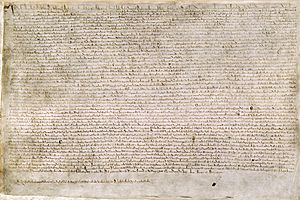Robert de Vere, 3rd Earl of Oxford facts for kids
Quick facts for kids
Robert de Vere
|
|
|---|---|
| 3rd Earl of Oxford | |

One of only four surviving 1215 exemplifications of Magna Carta, property of the British Library
|
|
| Born | after 1164 |
| Died | before 25 October 1221 Hatfield Regis Priory |
| Noble family | Vere |
| Spouse(s) | Isabel de Bolebec |
| Issue | Hugh de Vere, 4th Earl of Oxford Eleanor de Vere |
| Father | Aubrey de Vere, 1st Earl of Oxford |
| Mother | Agnes of Essex |
Robert de Vere (born after 1165 – died before October 1221) was an important English nobleman. He was the son of Aubrey de Vere, 1st Earl of Oxford and Agnes of Essex. Robert became the third Earl of Oxford after his brother passed away. He also held a special job called the Master Chamberlain of England, which was passed down in his family. Robert is famous for being one of the 25 powerful barons who made King John agree to the Magna Carta.
Contents
Robert de Vere's Early Life
Robert de Vere was the second son of Aubrey de Vere, 1st Earl of Oxford and his third wife, Agnes of Essex. We don't know exactly when he was born, but it was likely after the year 1164. Not much is known about Robert's early life.
Marriage and Family Connections
In 1207, Robert de Vere married Isabel de Bolebec. Isabel was a widow, meaning her first husband, Henry de Nonant, had died. Isabel and her sister, Constance, inherited land from their niece, who was also named Isabel de Bolebec. This niece had been married to Robert's brother, Aubrey de Vere, 2nd Earl of Oxford.
Becoming the Earl of Oxford
Robert's older brother, Aubrey de Vere, 2nd Earl of Oxford, died in late 1214. When this happened, Robert became the new Earl of Oxford. He also took over the important family job of Master Chamberlain of England. This job meant he was in charge of the King's household and treasury.
Robert and the Magna Carta
In 1215, Robert de Vere joined a group of powerful barons who were unhappy with King John. These barons met and forced the King to sign a very important document called the Magna Carta. This happened at a place called Runnymede on June 15, 1215.
A Guarantor of Freedom
Robert de Vere was chosen as one of the 25 barons who would make sure the King followed the rules of the Magna Carta. This document was a big step towards limiting the King's power and protecting the rights of the people.
Conflict with the King
Because Robert and the other barons stood up to King John, they were declared rebels by Pope Innocent III. This meant they were excommunicated from the church. Robert then joined the barons who offered the crown of England to Prince Louis of France.
Changing Sides in the War
Robert de Vere fought against King John. However, after King John captured Castle Hedingham in March 1216, Robert promised to be loyal to the King. But later that same year, he changed his mind again. He swore loyalty to Prince Louis at Rochester. Prince Louis then entered London and was declared King. He quickly took control of more than half of England.
Loyalty to the New King
King John died during this time of war. Many barons then left Prince Louis and decided to support King John's young son, Henry III. In 1217, Prince Louis gave Castle Hedingham back to Robert. Despite this, Robert decided to support the new King Henry III in October 1217. He was fully given back his lands and titles in February 1218.
Later Life and Legacy
Earl Robert worked as a judge for the King in 1220 and 1221. He passed away shortly before October 25, 1221.
He was buried at Hatfield Regis Priory. An image of him, called an effigy, was placed there. It shows him wearing chain mail armor, with his legs crossed, pulling his sword, and holding a shield with his family's coat of arms.
Issue
Robert de Vere and Isabel de Bolebec had one son:
- Hugh de Vere, 4th Earl of Oxford
Images for kids



